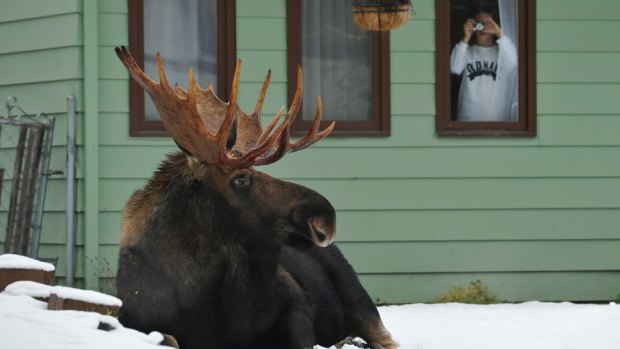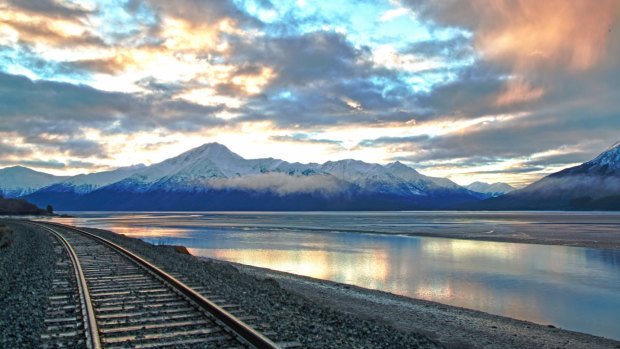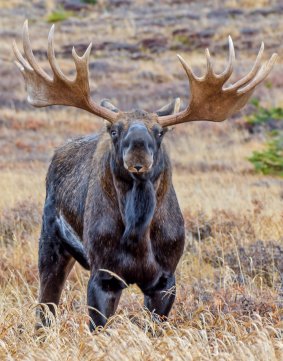By Luke Slattery

A moose hangs loose in Anchorage. Credit: Getty Images
The train to Anchorage from Seward, a pretty Alaskan harbour town astride the 60th parallel, clatters past glaciers that sweep out of the uplands to end in ragged walls of mint-coloured ice. Waterfalls cascade from the hills. The rods of fishermen linger expectantly over rivers swollen with snowmelt. Forests of spruce and alder carpet the valleys. Eagles weave and loop above.
It must rank as one of the globe's most spectacular train rides, though it is not often mentioned in the company of the more illustrious Rocky Mountain Express or Switzerland's Glacier Express, perhaps because it is just that little bit more remote: who goes to Seward? You certainly don't go through it.
I took the four-hour journey recently, in mid-summer, and what piqued my curiosity quite as much as the majestic landscape quivering with life was the narration of a guide in our carriage. In other countries the view would be allowed to unroll by itself in remote splendour, but not in America. Someone holding a mike had to talk it up.

Train tracks and mountains are illuminated by the sunrise over Turnagain Arm in south central Alaska. Credit: iStock
As the glass-topped train slid into Anchorage our guide gave a spiel about things to do in the gorgeous northern sunshine that day – about 20 hours of it. But she added a note of caution in her singsong Alaskan accent. "If you are out walking the coastal trail please keep an eye out for bears. You might also see moose – there are 1500 resident moose in Anchorage. They like it here, particularly in summer, as we provide meals for them in the form of nicely cut gardens. They are not afraid of anything; but then they are nervous of everything."
Although I failed to sight even one peripatetic moose during my uneventful 24-hours in Anchorage I did meet a local woman at a bar – as you do – who regaled me with tales of life in the north. An out-of-towner who comes to Anchorage often on business, she told of close encounters with bears, moose and even cougars; of the stupidity of some people (she'd seen a man throwing packets of chips to a bear wandering beside the highway), and the ill fortune of others.
"Just a few months ago two women were savaged by a moose on the city's coastal track," she went on, eyes widening as she waited for a response.

A bull moose during the fall rut season in Alaska.Credit: iStock
"Really?" I shot back a little dubiously. "Moose are that dangerous?"
As the story seemed somewhat apocryphal, or at least exaggerated in a tall-tales-from-the-frontier way, I had to check it out. And sure enough, there it was in the online edition of the Alaska Dispatch News. On May 27 local women Catherine Dwinnell and Melanie Sandstrom had been walking in parkland near the airport when they encountered a moose that seemed agitated. It was on them, Sandstrom recalled, "like a truck". The report went on:
"The moose, an adult female that might have weighed350 to 450 kilograms, stomped on each of them repeatedly. They both remember curling up in the fetal position. Feeling hooves on their shoulders, legs, arms, rear ends. They tried to protect their heads."
Intrigued by this story, I tootled around the web when I returned home to Sydney (I also contacted Anchorage Tourism seeking further information but my query was ignored). And sure enough, Anchorage has some serious moose issues. I found photos of moose with those grand arboreal antlers lying in gardens, rooting around in rubbish bins, cooling off in a kids' inflatable pool, crossing the streets – loitering in the streets.
The extent of the challenge is revealed by a quick crunch of the moose to non-moose (ie human) numbers in Anchorage; there's approximately one of the former for 200 of the latter. It's a little like living with a homeless population possessing some very distinctive features. Not only are the indigent of Anchorage four legged beasts the size of small trucks with antlers like pitchforks and hooves that can crush a skull, they are predisposed to take whatever they fancy rather than beg with bowls.
Here is an Alaskan joke:
Moose walks into a bar. Barman says, "Why the long face?"
In another fabulous Moose-scapade from the local paper, one of the creatures had apparently given birth outside an Anchorage hardware store. Well, that was how the first online reports had it. The story needed a bit of reportorial repair-work. The corrected version read: "A cow moose and newborn calf spent hours in the busy parking lot of an Anchorage hardware store Tuesday, to the delight of shoppers and bystanders who came to see the animals as word spread on social media."
As an Australian I recognise the trope well. In fact, while I was in Alaska news broke of a break-and-enter koala a family discovered on the couch of a coastal NSW home, warming itself before the fire on a cold winter day. By the time I heard the story, which was retailed to me at lunch by an American couple, it had been embellished to the point of absurdity and the koala was watching television. Animal Planet, I presume.
But there's a subtle difference between Australian and Alaskan wildlife encounters. City dwellers in Australia cohabit with menacing underfoot things – snakes and spiders – that are beyond our power to tame or control because they live largely out of sight (though never long out of mind). Larger creatures, like crocodiles, are far too dangerous to be afforded civic rights.
The northern moose – and to some extent the bear – come in a special category of protected species that are attracted to population centres and tolerated, to varying degrees, in them. If you see a bear rummaging around your front yard in the wild north you call a ranger. If you see a moose doing something extraordinary you text your friends – then call the Alaska Dispatch News. Being a ruminant, not a predator, the moose is more akin to the revered Indian cow than the feared and loathed Australian croc.
Bears love to poke around in the garbage. And they are a lot cuter than crocs or sharks. Besides, not every encounter between man and bear ends in a dinner where the former is paying (with life). "If you see a bear you either run or play dead," my interlocutor in Anchorage had told me. "They generally won't maul you." Until The Revenant messed with the bear's image Yogi and Baloo – companionable, kind hearted, bumbling bears – were our culture's ursine mascots.
There is something particular about Anchorage and its moose issues – and something universal, too. For our ancestors the moose, the bear, the bison, the whale, the otter, were sources of meat, skin, bone, oil; a plentiful resource, hacked from the wild out of perceived necessity.
A live bear was also a source of livelihood: the precursor of the Elizabethan theatre was the bear-baiting ring. The recovery of these creatures from the predations of earlier generations – their scarcity – has sentimentalised them in our eyes. Anyone who has ever heard the exaltations of a crowd sighting a whale, and then mapped that sentiment over a page of Moby Dick, will register this shift in feeling. The malevolent Leviathan is now the natural world's pop star.
That's no bad thing, but of course it is highly selective. Who gives a damn about the untold ducks whose down is plucked for our winter puffy jackets? But the big, heroic, beautiful wild creatures that engage our sympathies and imaginations seem oftentimes like conduits to some mystical state with which we have lost touch but which the cave paintings of the Australian Aborigines and the primitives of Lascaux invite us to contemplate.
I wonder if there is not something deeply atavistic about this renewed reverence for wild things. I don't see it in the Romantic era, which was more intensely focused on the pursuit of the sublime and solitary communion with nature, while the Enlightenment before it understood nature in the terms of burgeoning science and the opportunities for exploitation. Where the philosophers of the Enlightenment – Diderot, Voltaire and Rousseau – exalted nature, it was "natural man" and the "noble savage" that was the subject of their curiosity and their veneration. But it's there in the myths of the pagan world, many centuries earlier, where gods metamorphose into creatures – Zeus is a sometime swan, Apollo a dolphin, Artemis a bear – because the ways of the deity are as mysterious and ineffable as the ways of nature.
On the train from Seward to Anchorage the passengers in my carriage craned their necks in one collective movement when an eagle – creatures sacred to Zeus – swept overhead. At that moment a collective cry went up, much like the gushing of the whale spotters.
It's a contemporary twist on "the call", as Jack London so memorably put it, "of the wild". But where for the adventure writer of the great Northland there was something at once terrible and beautiful in this call, for contemporary people the sighting of a wild thing is a gift, a benediction, a visitation; and a photo opportunity. The sentimentilisation of wild things grows apace with our destruction of their worlds, or at least our gathering fears for those worlds.
The call of the wild – a call to experience the wild, to be touched by it, to catch its song, breathe its breath – is a powerful influence on the changing patterns of global tourism. The big trend in cruising is the growth of the expedition market, while visits to the poles are booming. The wild – or perhaps the mild wild viewed from a ship or a chopper – is where it's at.
Of course the wild has its dangers, as do the seemingly benign walking tracks of Anchorage on a midsummer day, where you can find yourself on the wrong end of a rampaging moose. And yet it's fast becoming the case that the dangers of the wild pale in comparison with the perils of one's own species. Or so it seems.
Sign up for the Traveller Deals newsletter
Get exclusive travel deals delivered straight to your inbox. Sign up now.